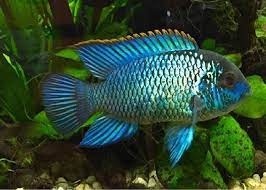Neon Blue Acara (70-80mm)
Neon Blue Acara (70-80mm)
check_circle Fast Shipping
check_circle Quality Products
check_circle Affordable Price
Reach out to us on ''available to order'' items via WhatsApp or email
Low stock: 6 left
Couldn't load pickup availability

Neon Blue Acara (70-80mm)
package_2
Product Description
Product Description
All our fish, shrimp and corals are bagged with fresh oxygen as well as a heat pack in winter.
When ordering livestock please select the box size and add it to your cart for accurate overnight (1-2 days) shipping costs. A small box can take 1-2 bags and a medium box 6 bags. One bag fits max 10 small (1-3cm) fish or max 2 medium (3-5cm) fish or max 1 large (>5cm) fish.
ONE SPECIES PER BAG. Eg: One bag of 10 neon tetra.
Blue Neon Acara (Andinoacara pulcher)
Description:
-
Appearance:
- Body: Oval and slightly elongated with a laterally compressed shape.
- Color: Vibrant blue body with neon blue or turquoise highlights. Often features a contrasting red or orange coloration around the eyes and fins.
- Fins: Fins are typically transparent with some color accents, such as blue or orange.
-
Size:
- Adult Size: Up to 6-8 inches (15-20 cm) in length.
-
Behavior:
- Temperament: Generally peaceful but can be territorial, especially during breeding.
- Activity: Active and often seen swimming around the tank. Can be a bit shy at first but usually becomes more confident over time.
Care Requirements:
-
Tank Size:
- Minimum: 30 gallons (114 liters) or larger. A larger tank is recommended to provide ample swimming space and to help reduce territorial behavior.
- Tank Shape: A longer tank is preferable to give them more horizontal swimming space.
-
Tank Setup:
- Substrate: Use fine gravel or sand. A softer substrate is preferable to avoid damaging their sensitive barbels.
- Decorations: Provide hiding spots and structures such as rocks, driftwood, and caves. They appreciate a well-structured environment with places to retreat.
- Plants: Live plants can be included but should be sturdy as they may be uprooted. Floating plants can also provide cover.
-
Water Parameters:
- Temperature: 74-78°F (23-26°C). Maintain a stable temperature.
- pH: 6.5-7.5. Slightly acidic to neutral water is ideal.
- Hardness: Moderate to hard water.
- Filtration: Provide good filtration to maintain water quality. A moderate flow is suitable, but avoid strong currents that can stress the fish.
-
Diet:
- Primary Food: Omnivorous. Feed a balanced diet including high-quality pellets, flakes, and frozen or live foods such as bloodworms, brine shrimp, and daphnia.
- Supplemental Food: Occasional treats of vegetables like blanched spinach or peas.
-
Behavioral Considerations:
- Compatibility: Generally compatible with other peaceful species of similar size. Avoid aggressive or overly territorial tank mates.
- Social Behavior: Can be kept in pairs or small groups, but provide enough space and hiding spots to reduce aggression.
-
Tank Maintenance:
- Water Changes: Regular water changes (20-30% weekly) to maintain water quality and reduce waste buildup.
- Cleaning: Regularly clean the tank and equipment. Remove uneaten food and debris to prevent water quality issues.
-
Health Care:
- Observation: Monitor for signs of stress or illness, such as changes in behavior, loss of appetite, or physical symptoms like discoloration or fin damage.
- Treatment: Consult an aquarium professional if health issues arise. Common problems include ich, fin rot, and fungal infections.


